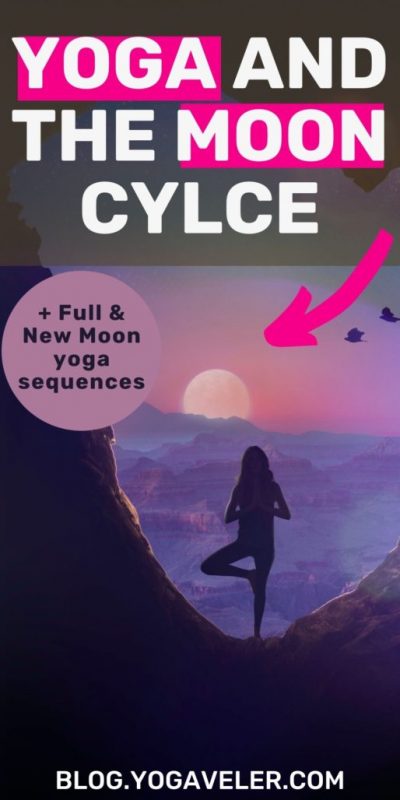What do yoga & the moon cycle have in common?
In this article, we explore the intricacies of the relationship between yoga and the moon cycle and share full and new moon yoga sequences as well as affirmations you can practice at home.
Did you know that skin cells regenerate every 30 days? But, what about the state of mind?
In the Vedic tradition, yoga is closely linked to the cycles of Life, the earth, and the stars that influence it, including its only satellite, THE MOON.
It seems that the strength of the lunar energy helps to find peace and serenity. Sleep, mood, and energy would be influenced by its cycles as well. So, I wanted to know more…
The Hatha Yoga tradition considers that we all have the sun (Surya) and the moon (Chandra) within us.
The sun represents our “masculine”, luminous side. The activity, the day, the heat. Exteriority, life, restlessness.
By opposition, the Moon symbolizes the “feminine” side, the mind, the night. Interiority, intimacy, but also death. Thus, according to Hatha yoga, certain postures are ideally practiced at certain parts of the lunar cycle, to better harmonize the energies.
In Ashtanga Yoga, this discipline was created by Sri K. Pattabhi Jois, practitioners abstain from practice during a full moon and a new moon.
According to Sri Pattabhi, this goes back to an ancient belief about the alignment of some celestial bodies (Earth, Moon, and Sun), which results in a tenfold increase in energy at that time.
Prana, the rising energy, being at its peak at the full moon, and Apana, the falling energy, reaching its peak at the new moon.
The moon as a spiritual guide
The cycle of the moon acts as a guide to the Yogi/ni. A magical dimension that reminds us of the importance of rituals. It nourishes our yoga. Accompanies us, inspires us.
The full moon and the new moon become times to observe, whether we choose to focus on certain postures, fast, or refrain from setting foot on our mat.
Especially if you practice intensely and daily you know that it is necessary to listen to your body and let it rest.

Series of postures to honor the full moon
At the next full moon, why not replace Surya Namaskar, your sun salutations, by Chandra Namaskar, moon salutations?
Start in Tadasana, then on one breath, raise your arms to the sky. The hands meet above your head.
Exhale to lean the bust to the right, in a crescent moon shape.
Inhale to begin the transition to the goddess posture: and exhale with your buttocks lowered.
Inhale and without moving your feet, stretch out your legs and arms in the five-pointed star posture.
Exhale to assume the triangle posture on your right leg.
Inhale to rotate your left foot into the pyramid posture with your back straight – then exhale, sending your stomach towards your right thigh and your nose towards your leg.
Exhale to go into a slit on your right leg, left foot far back on the mat, knee on the floor or not.
Inhale, fingers touching the floor and moving forward, then up and back, with a slight curve in the back if you wish.
Exhale to rest the fingers on each side of the right foot.
Inhale, pass your bust to the left of the mat in a low slit on the side.
Exhale while tilting into the same posture on your other foot and do the exact opposite path, with all postures mirrored on the other side.
You can now start again from the last posture to the first one, and repeat as many times as you wish.
You can also choose to remain several breaths in each posture, for a slower, more meditative version.
Of course, don’t hesitate to protect your knees with a yoga mat and to use a brick to bring the floor to you in any asana that requires it.
There are several versions of Chandra Namaskar, which you can test before finding the one that really makes you vibrate.
Some yoga postures to practice for the New Moon
If you want a little challenge, practice the above moon salutations and add the half-moon posture, in balance.
Symbolizing silence and acceptance of death, Ardha Chandrasana will bring you much stability, peace, and calm.
Accept your fears and take your time, be patient with yourself.
Remember that it is always the posture that adjusts to you, your abilities, your desires, your energy of the day.
Thus, you may decide to take a break and prefer soft postures that anchor you in the ground and the moment.
Choose a new intention for this lunar cycle that is beginning.
Bow to something huge, much bigger than you – whatever it is, make it speak to you, deep down.

Some affirmations for different phases of the moon
New Moon = new intention: “I give birth to what my heart desires”.
First crescent, I install this intention, I make it mine, I meditate on it: “I deserve what my heart desires”.
First-quarter, I put myself in action and I allow myself a few slips, I adjust. “I try with all my heart”.
Full Moon, I take the time to line up: “I know what no longer serves me”.
Last quarter, I note the changes that take place: “I am attentive to the signs”.
Last Crescent, I express all my gratitude: “I thank the Moon for its guidance”.
New Moon, new intention (or re-affirmation of my Sankalpa)
Did you find this post useful? Save THIS PIN below to your Pinterest Yoga board on Pinterest for later!
Wanna know more? 👉 In this article, we explore the Vedic Astrology method that is highly influenced by the moon, check it out!


